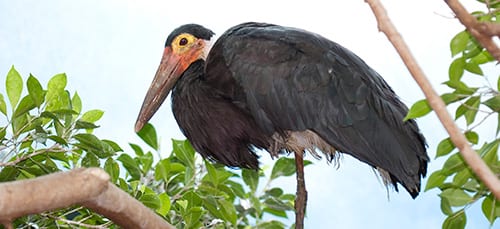Where They Hang Out
At the zoo: in Bird World
In the wild: the Amazon Rainforest
Favorite Foods
At the zoo: Chopped fruits, vegetables, nectar waxworms and mealworms
In the wild: fruit and occasionally insects
Social Life
Spangled cotingas live in small groups of males and females. They feed socially and use a call to warn the group of approaching predators
About Skylar
Cotinga cayana
Introducing our feathered friend Skyler. He is a spangled cotinga (Cotinga cayana). Skyler was hatched on September 15, 2001 making him a senior citizen of his species. His species is native to the Amazon rainforest canopy in South America.
This species is sexually dimorphic, meaning that the male and female look different. Skyler, our male, is a bright turquoise-blue with a deep wine-red, almost purple, throat and black on his wings, tail and back. The females are overall brownish-gray with darker wings. We currently do not have a female, so Skyler is a bachelor living the single life and his keepers pamper him.
Skyler eats many different kinds of food here at Denver Zoo including mealworms, apples, banana, pears, grapes and carrot. His favorites are waxworms and low iron pellets. Skyler had a shoulder injury a long time ago and as a result he is a now a weak flier. Here at the zoo we can adjust his environment to make it easier for him to get around. You will see that he has a food stations low in his exhibit to make it easily accessible and his water is lower to ensure his safety. There are also lots of low branches for him to perch on.
Skyler is a member of the family, Cotingidae. This is a very diverse family that includes cock-of-the-rock, umbrellabirds, bellbirds, fruitcrows and many others. They all have broad bills with hooked tips, rounded wings, and strong legs. Sexual selection has resulted in brilliant male colors and vocalizations. Many members of this family also have intricate breeding displays.
You can visit him at his current home in the first window of the last hallway of Bird World just before you leave the building. Visit Denver Zoo in February for a full month of feathered friend fun! Find out more on the website.

